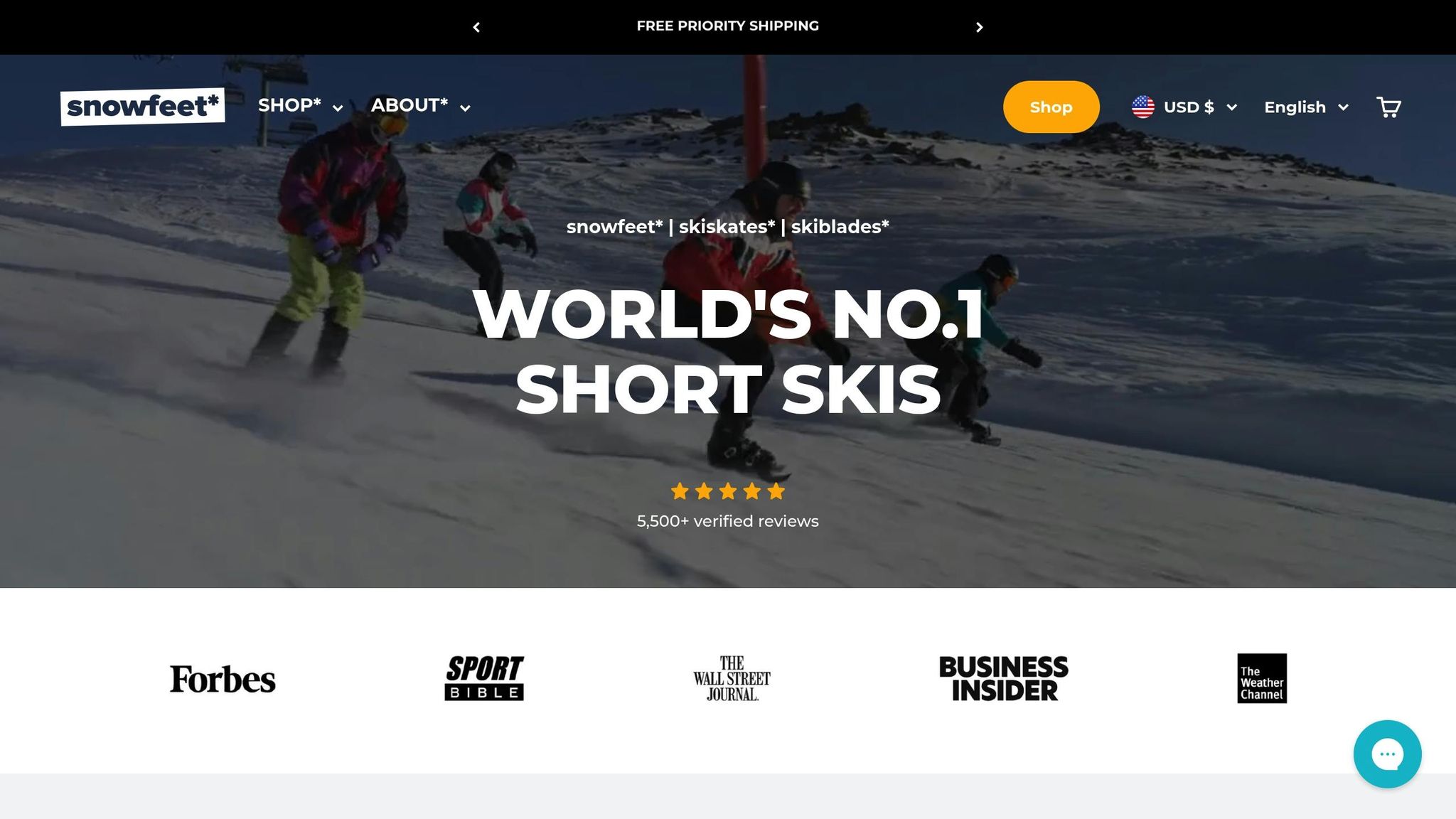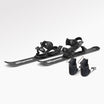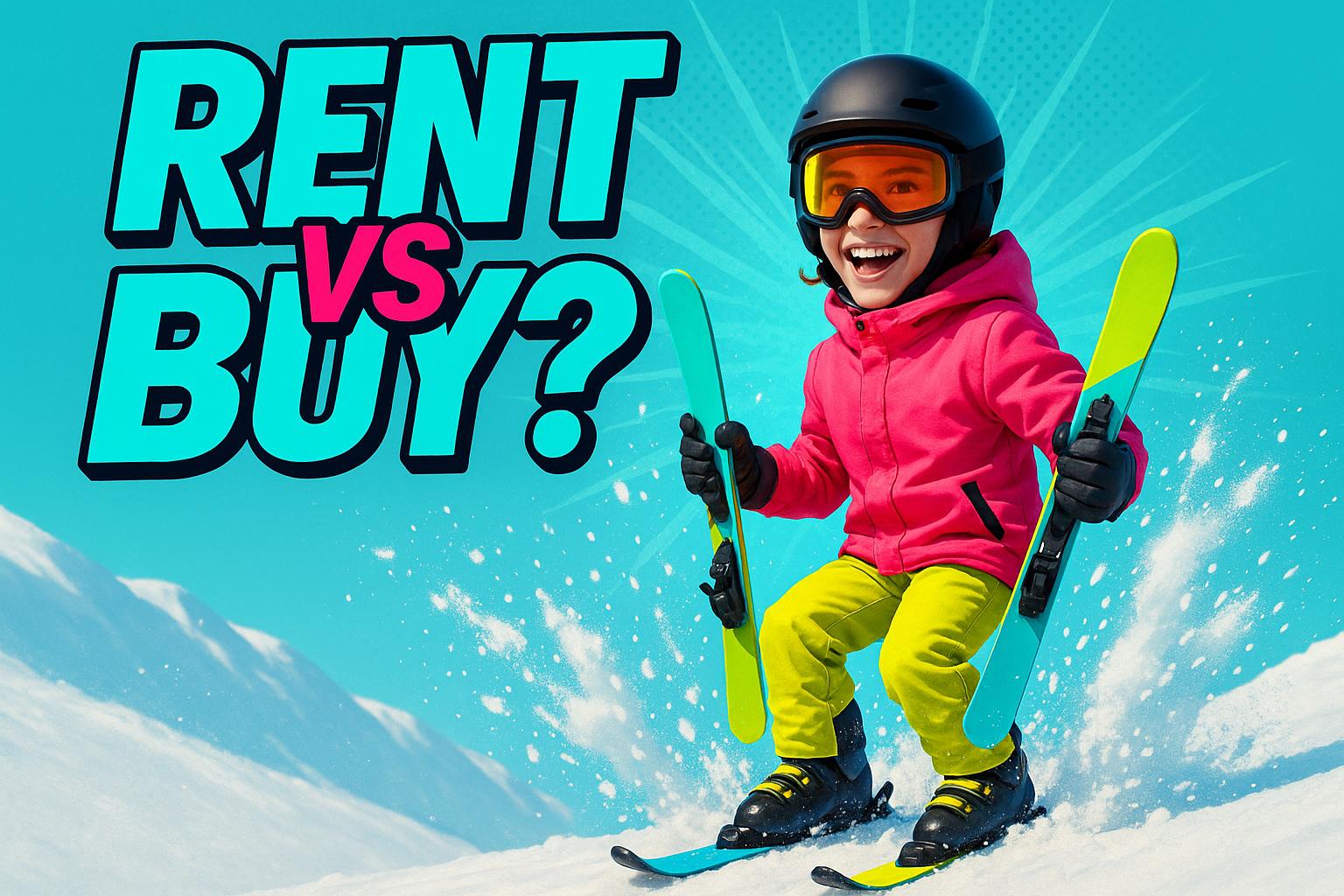En matière de ski, cher ne signifie pas toujours mieux - surtout pour la plupart des skieurs récréatifs. Les skis haut de gamme peuvent coûter entre 800 $ et 1 200 $ et sont souvent conçus pour des conditions spécifiques ou des techniques avancées. Mais faut-il dépenser autant pour une excellente expérience ? Pas forcément.
Voici Snowfeet* : une marque proposant des skis courts et Skiskates à partir de seulement 150 $. Ces options compactes et abordables sont faciles à utiliser, portables et adaptées à plusieurs terrains. Elles sont parfaites pour les débutants et les skieurs occasionnels qui veulent s'amuser sans les tracas ni le coût des skis longs traditionnels.
Voici un résumé rapide :
- Snowfeet* : abordable, facile à apprendre, portable et polyvalent.
- Skis longs : excellents pour la vitesse et la neige profonde mais coûteux, encombrants et plus difficiles à maîtriser.
Pour la plupart des skieurs, Snowfeet* offre une façon plus simple et économique de dévaler les pistes sans sacrifier le plaisir. Plongeons dans les détails !
Les skis les PLUS CHERS et pourquoi je les DÉTESTE : Revue BOMBER Ski
1. Snowfeet* Skis courts et Skiskates

Snowfeet* s'est fait un nom en défiant la mentalité « plus long c'est mieux » qui domine le monde du ski. Leur gamme prouve que vous n'avez pas besoin de dépenser beaucoup pour obtenir performance et polyvalence. Pour les skieurs américains, les skis courts et Skiskates Snowfeet* apportent une touche de fraîcheur grâce à leur design astucieux et leur praticité.
Qualité de fabrication
Les produits Snowfeet*, comme les Skiskates avec leur construction en bois, sont robustes et offrent des performances élevées - rivalisant avec des skis traditionnels plus chers. Des modèles tels que le Snowfeet PRO disposent de fixations réglables conçues pour un usage fréquent sur différentes conditions de neige. Contrairement aux marques de skis traditionnelles qui vous enferment souvent dans des systèmes de fixation propriétaires coûteux, Snowfeet* garde les choses simples et abordables avec des designs durables et sans complications.
Ces skis et Skiskates sont prêts à l'action, que vous glissiez sur des pistes damées ou que vous affrontiez des sentiers hors-piste. Les compacts Mini Ski Skates, par exemple, se glissent facilement dans un sac à dos tout en résistant aux exigences du ski sérieux. Cette construction robuste garantit qu'ils sont prêts pour toutes les aventures que vous leur réservez.
Polyvalence
Quand il s'agit de polyvalence, Snowfeet* se démarque. Les marques traditionnelles comme Rossignol ou Salomon vous obligent souvent à choisir des skis spécifiques pour des conditions spécifiques. Snowfeet*, en revanche, fonctionne sur plusieurs terrains. De plus, ils sont compatibles avec des chaussures d'hiver classiques, vous évitant ainsi les tracas et le coût de la location ou de l'achat de chaussures de ski coûteuses. Que vous dévaliez les pistes, jouiez dans un snowpark ou randonniez sur un sentier enneigé, Snowfeet* s'adapte à vos plans.
Les skis traditionnels peuvent vous enfermer dans une utilisation limitée. Par exemple, une paire de Völkl de course peut briller sur les pistes damées mais décevoir en poudreuse. Les modèles Snowfeet* comme les Skiblades (99 CM), en revanche, sont conçus pour le carving, les modules de park et une variété de conditions de neige. Et en matière de portabilité, Snowfeet* est un gagnant clair - fini la galère pour caser de longs skis dans une petite voiture ou dans les transports en commun.
Performance
Vous pensez que des skis plus longs signifient un meilleur contrôle ? Pas toujours. Les skis plus courts, comme ceux de Snowfeet*, offrent une plus grande agilité et sont plus faciles à apprendre. Leur poids de balancement réduit facilite les transitions rapides d'arête à arête et aide à réduire la fatigue lors de longues sessions. Les débutants peuvent commencer à tailler des virages presque immédiatement, tandis que les skieurs expérimentés adoreront les virages rapides et précis ainsi que la capacité à naviguer dans des passages étroits. Cette maniabilité accrue ne fait pas que renforcer l'expérience - elle vous fait aussi économiser de l'argent en rendant le ski plus accessible.
Coût
C'est ici que Snowfeet* fait vraiment la différence. Les skis longs traditionnels peuvent coûter entre 800 $ et 1 200 $ - et ce, avant d'ajouter les fixations et les chaussures. Snowfeet* propose des solutions complètes à une fraction de ce prix. Leur tarification claire signifie que vous savez exactement ce que vous payez, sans frais cachés ni surprises. Pour les skieurs américains cherchant la performance sans se ruiner, Snowfeet* est un choix évident.
2. Skis longs traditionnels
Les skis longs traditionnels de marques comme Rossignol, Salomon, K2 et Völkl ont souvent un prix élevé, laissant beaucoup se demander s'ils valent l'investissement. En termes de construction, d'adaptabilité, de performance et de coût, ces skis peuvent représenter un engagement difficile à justifier par rapport à des options plus récentes et plus accessibles.
Qualité de fabrication
Des fabricants de premier plan comme Blizzard et Atomic utilisent des matériaux avancés et des conceptions multicouches pour rendre leurs skis durables et performants. Mais voici le hic : leurs systèmes de fixation propriétaires nécessitent souvent des dépenses supplémentaires et une installation professionnelle. Pour le skieur récréatif moyen, cette complexité et cet entretien supplémentaires peuvent sembler excessifs, surtout si vous ne skiez pas tous les week-ends.
Polyvalence
Les skis longs traditionnels ont tendance à se concentrer sur des styles de ski spécifiques. Certains modèles sont fantastiques pour les pistes damées mais peinent dans la neige plus molle, tandis que les skis all-mountain peuvent sembler encombrants lorsque vous naviguez dans des espaces étroits ou changez rapidement de terrain. De plus, ils nécessitent souvent des chaussures, des bâtons et d'autres équipements spécialisés - et parfois même plusieurs paires de skis pour gérer différentes conditions. Leur longueur complique aussi le transport et le stockage, ce qui peut limiter vos aventures de ski aux stations proches.
Performance
Il est indéniable que les skis longs traditionnels excellent en stabilité à grande vitesse et en flottaison dans la neige profonde. Mais ils exigent plus de force et une technique précise, ce qui peut fatiguer les débutants - et même certains skieurs intermédiaires. Des virages rapides ? Cela peut vraiment être un effort physique. Au lieu de profiter des pistes, vous pourriez vous retrouver à lutter pour contrôler votre équipement, ce qui peut gâcher le plaisir.
Coût
Obtenir un équipement complet auprès des grandes marques peut représenter un investissement sérieux. Au-delà des skis eux-mêmes, il y a les chaussures coûteuses, les frais de montage et les coûts d'entretien continus. Et n'oublions pas la dépréciation - les skis traditionnels perdent rapidement de la valeur, avec de nombreuses options d'occasion inondant le marché chaque automne lorsque les skieurs passent aux derniers modèles. Si vous skiez seulement occasionnellement, l'engagement financier peut ne pas sembler rentable. En revanche, Snowfeet* offre une alternative plus abordable et polyvalente, vous permettant de dévaler les pistes sans vous ruiner.
sbb-itb-17ade95
Analyse des avantages et inconvénients
Lorsqu'on choisit entre les Snowfeet* short skis et les skis longs traditionnels, les différences sont assez claires. Voici un aperçu des principaux facteurs que les skieurs considèrent généralement :
| Facteur | Snowfeet* Short Skis | Skis longs traditionnels |
|---|---|---|
| Coût initial | 150 $–690 $ pour un équipement complet | 800 $–2 500 $+ (inclut skis, chaussures, fixations et montage) |
| Courbe d'apprentissage | Les bases maîtrisées en 1 à 2 jours | Il faut généralement des semaines à des mois pour acquérir de la maîtrise |
| Portabilité | Super portables ; se glissent facilement dans un sac à dos | Encombrants ; nécessitent un sac à skis dédié et une planification supplémentaire |
| Polyvalence | Fonctionne sur les pistes, dans les snowparks, et même dans les jardins | Mieux adaptés aux stations et terrains spécifiques |
| Entretien | Minimal - un fartage basique peut être fait à la maison | Nécessite un réglage régulier, un affûtage des carres et un entretien professionnel |
Les Snowfeet* courts se distinguent par leur prix abordable, leur facilité d'utilisation et leur praticité. Leur taille compacte signifie que vous pouvez les glisser dans un sac à dos et partir pour des aventures spontanées - que ce soit une colline locale, un sentier de randonnée enneigé, ou même votre jardin après une chute de neige fraîche. Pour quiconque cherche une façon ludique et sans engagement de profiter des sports d'hiver, c'est une évidence.
Cela dit, les skis longs traditionnels brillent toujours dans certaines situations. Ils sont idéaux pour les descentes à grande vitesse sur des pentes raides et excellent dans la poudreuse profonde, où leur longueur aide à la portance et à la stabilité. Les stations et les pistes damées sont leur habitat naturel, offrant la performance et le contrôle que recherchent souvent les skieurs avancés.
Maintenant, parlons des compromis. Les Snowfeet* ont quelques limitations. Ils n'atteignent pas les mêmes vitesses de pointe que les skis longs, et dans une neige très profonde, vous pourriez devoir ajuster votre technique. Mais pour la plupart des skieurs récréatifs, ce ne sont pas des obstacles majeurs. La flexibilité et la facilité d'utilisation des Snowfeet* compensent largement ces petits inconvénients.
Les skis longs traditionnels, en revanche, présentent une longue liste d'inconvénients. Le coût initial est nettement plus élevé, et lorsque vous ajoutez les forfaits de remontée, les frais de station, les cours et l'entretien régulier, les dépenses peuvent vraiment s'accumuler. Le stockage et le transport sont un autre casse-tête - un équipement encombrant n'est pas vraiment synonyme de commodité. De plus, les virages rapides demandent plus d'efforts, ce qui peut enlever un peu de plaisir au ski occasionnel.
L'entretien est un autre point sensible. Les skis longs nécessitent un réglage professionnel fréquent, tandis que Snowfeet* n'ont besoin que d'un cirage occasionnel, ce qui vous fait gagner du temps et de l'argent. Et n'oublions pas la liberté qu'apportent les Snowfeet*. Vous n'êtes pas lié aux horaires des stations ou aux forfaits de remontées mécaniques coûteux, rendant les sports d'hiver plus accessibles à tous. Cette barrière à l'entrée plus basse suscite souvent l'intérêt parmi les amis et la famille qui, autrement, pourraient hésiter à cause des coûts et des engagements liés au ski traditionnel.
Verdict final
Pour la plupart des skieurs américains, dépenser beaucoup d'argent pour des skis coûteux n'a tout simplement pas de sens.
Bien sûr, les skis longs traditionnels ont souvent un prix élevé car ils sont conçus pour des scénarios spécifiques à haute performance - comme les courses compétitives ou l'exploration de terrains accidentés en hors-piste. Mais soyons réalistes : si vous restez sur des pistes damées, des snowparks ou votre colline locale préférée, payer plus pour ces légères améliorations de performance pourrait simplement vider votre portefeuille sans vraiment améliorer votre expérience globale.
C'est là que Snowfeet* intervient et renverse la situation. Ces mini skis allient plaisir, accessibilité et polyvalence à un prix difficile à battre. Prenez par exemple les 38cm Mini Ski Skates - ils offrent beaucoup de valeur et de plaisir sans les coûts élevés liés aux équipements de ski traditionnels.
Snowfeet* change aussi la donne en éliminant les tracas des voyages en station et du matériel encombrant. Avec leur courbe d'apprentissage rapide et leur design léger, vous pouvez vous lancer directement dans l'action - que ce soit pour tracer des courbes dans votre parc local, explorer des sentiers enneigés ou même réaliser des figures dans votre jardin. Contrairement aux skis traditionnels, qui exigent des forfaits de remontées mécaniques coûteux, un équipement encombrant et des horaires stricts, Snowfeet* vous permet de profiter du ski à votre façon. Pas de leçons chères, pas de trajets stressants en télésiège, et pas de chutes douloureuses sur des pentes raides.
En regardant vers 2025 et au-delà, les short skis sont clairement l'avenir. Que ce soit les 44cm Skiskates à 390 $ ou les 120cm Short Skis à 690 $, ces options offrent une approche moderne, flexible et amusante des sports d'hiver. Ils sont conçus pour la façon dont la plupart des gens veulent réellement skier - en mettant l'accent sur la liberté, la facilité et le plaisir maximal.
FAQs
Comment les Snowfeet short skis se comportent-ils par rapport aux skis longs traditionnels pour les débutants et les skieurs occasionnels ?
Les Short Skis Snowfeet sont une option fantastique pour les débutants et les skieurs occasionnels car ils sont légers, faciles à manier, et super agiles. Contrairement aux skis longs traditionnels qui peuvent sembler encombrants et difficiles à gérer, les Short Skis Snowfeet facilitent les virages, le maintien de l'équilibre, et l'apprentissage des bases rapidement. Cela signifie moins de stress et plus de plaisir pour les nouveaux skieurs.
Alors que les skis longs sont excellents pour la stabilité à haute vitesse, ils demandent souvent plus de compétence, de force et d'expérience pour bien les utiliser. Les Short Skis Snowfeet, en revanche, offrent une glisse plus indulgente et qui booste la confiance, les rendant idéaux pour ceux qui débutent ou qui veulent simplement une journée détendue sur les pistes. Ils simplifient la complexité, rendant le ski plus simple, plus accessible, et - surtout - super amusant.
Qu'est-ce qui fait des produits Snowfeet un excellent choix pour skier sur différents terrains et dans diverses conditions ?
Les Skiblades Snowfeet combinent polyvalence et performance. Leur design léger et compact vous offre un contrôle incroyable que vous dévaliez des pistes damées, affrontiez des plaques de glace, flottiez dans une poudreuse profonde, ou même naviguiez sur un terrain plus accidenté. En gros, ils sont conçus pour gérer à peu près tout, ce qui en fait une excellente option toute l'année pour les skieurs de tous niveaux.
Un autre grand avantage ? Ils sont super portables. Contrairement aux skis ou snowboards traditionnels, ceux-ci sont faciles à transporter et ne viennent pas avec le prix élevé ni l'encombrement. Que vous affrontiez des conditions difficiles ou que vous cherchiez simplement une façon amusante et flexible de dévaler les pistes, Snowfeet Skiblades offrent un mélange unique de commodité et de performance.
Que dois-je prendre en compte en choisissant Snowfeet plutôt que des skis traditionnels ?
Snowfeet : une touche ludique pour dévaler les pistes
Les produits Snowfeet apportent un vent de fraîcheur aux sports d'hiver, offrant une alternative aux skis traditionnels. Mais avant de vous lancer, il y a quelques points à considérer. En raison de leur taille compacte, ils n'ont pas autant de surface, ce qui signifie qu'ils peuvent être moins stables dans la neige profonde ou en terrain hors-piste. De plus, leur grande maniabilité peut demander un temps d'adaptation - surtout si vous êtes débutant habitué à la sensation plus longue et stable des skis traditionnels.
Voici où Snowfeet se démarque vraiment. Leur design léger et portable en fait un rêve pour les sorties occasionnelles, les aventures de ski urbain, ou même simplement à glisser dans un sac pour un transport facile. Ils sont amusants, polyvalents, et ne coûtent pas une fortune, offrant une excellente façon de profiter des pistes sans les tracas ni le coût du matériel de ski traditionnel.
Articles de blog connexes
- Snowfeet Skiblades : des Short Skis abordables pour tous
- Pourquoi les skis sont-ils si chers ? Comprendre la technologie & les coûts
- Les fixations de ski chères valent-elles le coût supplémentaire ? (Une analyse d'acheteur)
- Les skis All-Mountain sont-ils vraiment bons pour tout ? (Une perspective 2025)


































Laisser un commentaire
Ce site est protégé par hCaptcha, et la Politique de confidentialité et les Conditions de service de hCaptcha s’appliquent.